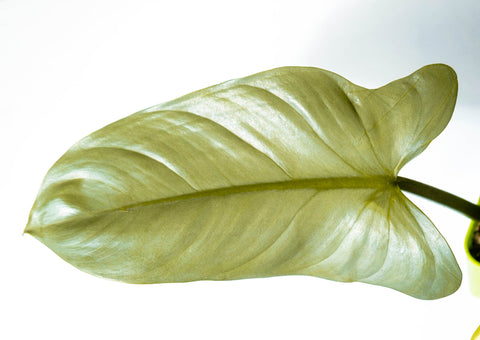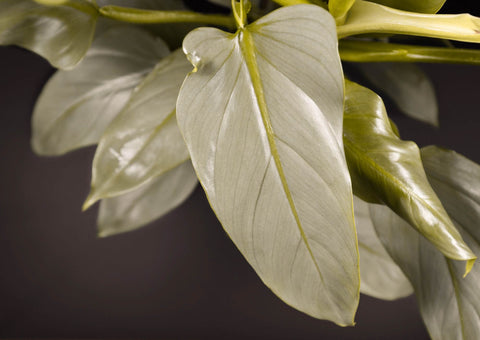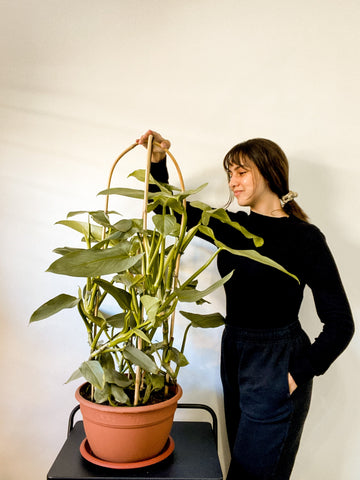During a recent visit to my local nursery, I stumbled upon the enchanting Philodendron Hastatum. Its large, thick leaves immediately caught my attention, and I had a hunch that it belonged to the Philodendron family. However, this particular variety was unfamiliar to me, and I was intrigued by its unique qualities.
The overall size of the plant was impressive, and what truly fascinated me was the foliage color. Unlike the typical vibrant greens of most indoor plants, it had a muted tone with subtle blue undertones, giving it a shimmering silver appearance. Without hesitation, I knew I had to bring this captivating plant home with me.
Upon conducting some research, I identified the plant I had encountered as the Philodendron Hastatum, commonly known as the Philodendron Silver Sword. It didn't take long for me to discover that this particular species is currently endangered due to the decline of its natural habitat in the Brazilian rainforests.
This newfound knowledge only deepened my appreciation for the plant and solidified my decision to include it in my collection. The opportunity to not only enjoy its exquisite beauty but also contribute to the conservation of a threatened species is undeniably compelling.
Benefits of Growing a Philodendron Hastatum

Philodendron Hastatum, commonly known as silver sword Philodendron or silver Philodendron, is an ideal choice for indoor gardeners looking for a plant that is both gorgeous and low-maintenance. Here are some of the main benefits of owning and caring for this stunning plant:
1. Low Maintenance
As a member of the esteemed Philodendron family, the Philodendron Hastatum stands out with its remarkable ease of care. This resilient plant boasts exceptional drought tolerance, requiring only a weekly watering routine, during the summertime, that even the busiest of gardeners can effortlessly manage. Moreover, the Philodendron Hastatum exhibits remarkable resistance to pests, ensuring an indoor gardening experience that is hassle and critter-free
2. Air Purifying
Similar to its Philodendron counterparts, the Philodendron Hastatum not only graces your space with its beauty but also plays a vital role in purifying the surrounding air. This remarkable plant acts as a natural air cleanser, eliminating harmful toxins such as benzene, formaldehyde, and trichloroethylene. With its inherent ability to improve indoor air quality, the Philodendron Hastatum creates a fresh and rejuvenating environment, ensuring both aesthetic pleasure and a healthier living space.
3. Stylish
Renowned for its uniqueness, the Philodendron Hastatum stands out as an exceptional plant with its extraordinary blue-silver foliage. Its distinctive coloration adds an element of elegance and sophistication to any space it graces. Moreover, the Philodendron Hastatum's versatility extends beyond its aesthetic appeal. As a vining plant, it can be artfully styled in numerous ways, whether you choose to suspend it gracefully from the ceiling or provide it with a supportive structure to climb upon.
Philodendron Hastatum Care Guide

While the Philodendron hastatum is celebrated for its low-maintenance nature, it's important to note that this doesn't imply neglecting it in a forgotten corner. To ensure your Philodendron hastatum flourishes rather than merely survives, adhering to these guidelines is key. By following these recommendations, you'll provide the optimal care and attention needed for your Philodendron hastatum to truly thrive and showcase its full potential.
Soil Requirements for Philodendron Hastatum
The Philodendron hastatum prefers soil that is rich in organic matter and well-draining. Adding sand or perlite should help drainng and prevent water from lingering around the roots and causing root rot. Add worm castings or compost to the soil to ensure the plant gets sufficient nutrients.
Watering and Humidity Needs for Philodendron Hastatum
Philodendron Hastatum prefers to be kept slightly moist but not waterlogged. Water the plant once a week, allowing the soil to dry out slightly between waterings. If the leaves start to droop, it's a sign that the plant needs water. In addition, Philodendron Hastatum prefers high humidity levels. You can increase humidity around the plant by placing a tray of water nearby or misting the leaves with water once a week.
Fertilizing Philodendron Hastatum
Philodendron Hastatum benefits from regular fertilization during the growing season (spring and summer). Use a balanced fertilizer that is high in nitrogen to promote healthy foliage growth. Follow the instructions on the package for application rates.
Propagating Philodendron Hastatum
Philodendron Hastatum can be propagated by stem cuttings. To do this, take a cutting from the plant that is around 10-15 cm (4-6 inches) long and has at least two leaves. Dip the cut end of the stem into rooting hormone and plant it in a pot filled with moist soil. Water the soil and cover the pot with a plastic bag to create a humid environment. Keep the pot in a warm, bright location, and the cutting should start to root in a few weeks.
Common Pests and Diseases of Philodendron Hastatum
Philodendron Hastatum is generally resistant to pests and diseases. However, it can be susceptible to spider mites, mealybugs, and scale insects. To prevent these pests from infesting your plant, keep it clean and dust-free, and inspect it regularly for signs of infestation. If you notice pests, treat the plant with neem oil or insecticidal soap.
Decorating with Philodendron Hastatum

Embracing the versatility of the Philodendron hastatum as a captivating decor element in your home opens up a realm of possibilities. To assist you in harnessing its aesthetic potential, here are some practical tips for styling your Philodendron hastatum with finesse:
1. Hanging Plant
The Philodendron hastatum effortlessly transforms into a stunning hanging plant. By placing it in a basket and suspending it from the ceiling, you can enjoy its beauty at eye level, maximizing the viewing pleasure. In case you're unable to drill holes in your ceiling due to rental constraints, an alternative solution is to utilize your curtain rods to hang the baskets. This way, you can still appreciate the charm of the Philodendron hastatum in your living space without any hassle.
2. Climbing Plant
Philodendrons, being climbing plants, offer the flexibility to be trained on various trellises of different heights and sizes. This method of displaying Philodendrons can result in the leaves growing notably large, so it's good to keep that in mind while planning. By considering the potential leaf size, you can create a charming arrangement that embraces the natural growth patterns of the Philodendron while maintaining a balanced and visually appealing display.
3. Grouped with other plants
Philodendron Hastatum thrives when grouped with other plants, creating a stunning visual composition. Plant it in a pot alongside other plants featuring contrasting foliage colors or textures for an eye-catching display. The combination of Philodendron Hastatum's elegant silver leaves with vibrant hues or textured foliage forms a harmonious and captivating arrangement, elevating the overall aesthetic of your indoor garden.
Philodendron Hastatum, with its striking beauty, effortlessly complements a wide range of spaces and adapts to diverse interior conditions. Beyond its aesthetic appeal, it holds special significance as an endangered species, making it a remarkable addition to your urban jungle. By including the Philodendron hastatum in your botanical collection, you not only enhance the visual allure of your indoor oasis but also contribute to the conservation efforts for this precious plant species. Embrace the opportunity to create a sanctuary for this extraordinary plant, adding both a touch of natural elegance and a sense of environmental responsibility to your urban haven.





